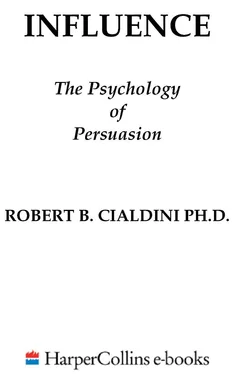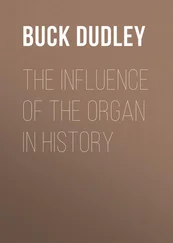Although some of Langer's additional findings show that there are many situations in which human behavior does not work in a mechanical, tape-activated way, what is astonishing is how often it does. For instance, consider the strange behavior of those jewelry-store customers who swooped down on an allotment of turquoise pieces only after the items had been mistakenly offered at double their original price. I can make no sense of their behavior, unless it is viewed in click, whirr terms.
The customers, mostly well-to-do vacationers with little knowledge of turquoise, were using a standard principle—a stereotype—to guide their buying: "expensive = good." Thus the vacationers, who wanted "good" jewelry, saw the turquoise pieces as decidedly more valuable and desirable when nothing about them was enhanced but the price. Price alone had become a trigger feature for quality; and a dramatic increase in price alone had led to a dramatic increase in sales among the quality-hungry buyers. Click, whirr!
It is easy to fault the tourists for their foolish purchase decisions. But a close look offers a kinder view. These were people who had been brought up on the rule "You get what you pay for" and who had seen that rule borne out over and over in their lives. Before long, they had translated the rule to mean "expensive = good." The "expensive = good" stereotype had worked quite well for them in the past, since normally the price of an item increases along with its worth; a higher price typically reflects higher quality. So when they found themselves in the position of wanting good turquoise jewelry without much knowledge of turquoise, they understandably relied on the old standby feature of cost to determine the jewelry's merits.
Although they probably did not realize it, by reacting solely to the price feature of the turquoise, they were playing a shortcut version of betting the odds. Instead of stacking all the odds in their favor by trying painstakingly to master each of the things that indicate the worth of turquoise jewelry, they were counting on just one—the one they knew to be usually associated with the quality of any item. They were betting that price alone would tell them all they needed to know. This time, because someone mistook a for a "2," they bet wrong. But in the long run, over all the past and future situations of their lives, betting those shortcut odds may represent the most rational approach possible.
In fact, automatic, stereotyped behavior is prevalent in much of human action, because in many cases it is the most efficient form of behaving, and in other cases it is simply necessary. You and I exist in an extraordinarily complicated stimulus environment, easily the most rapidly moving and complex that has ever existed on this planet. To deal with it, we need shortcuts. We can't be expected to recognize and analyze all the aspects in each person, event, and situation we encounter in even one day. We haven't the time, energy, or capacity for it. Instead, we must very often use our stereotypes, our rules of thumb to classify things according to a few key features and then to respond mindlessly when one or another of these trigger features is present.
Sometimes the behavior that unrolls will not be appropriate for the situation, because not even the best stereotypes and trigger features work every time. But we accept their imperfection, since there is really no other choice. Without them we would stand frozen—cataloging, appraising, and calibrating—as the time for action sped by and away. And from all indications, we will be relying on them to an even greater extent in the future. As the stimuli saturating our lives continue to grow more intricate and variable, we will have to depend increasingly on our shortcuts to handle them all.
The renowned British philosopher Alfred North Whitehead recognized this inescapable quality of modern life when he asserted that "civilization advances by extending the number of operations we can perform without thinking about them." Take, for example, the "advance" offered to civilization by the discount coupon, which allows consumers to assume that they will receive a reduced purchase price by presenting the coupon. The extent to which we have learned to operate mechanically on that assumption is illustrated in the experience of one automobile-tire company. Mailed-out coupons that—because of a printing error—offered no savings to recipients produced just as much customer response as did error-free coupons that offered substantial savings. The obvious but instructive point here is that we expect discount coupons to do double duty. Not only do we expect them to save us money, we also expect them to save us the time and mental energy required to think about how to do it. In today's world, we need the first advantage to handle pocketbook strain; but we need the second advantage to handle something potentially more important—brain strain.
It is odd that despite their current widespread use and looming future importance, most of us know very little about our automatic behavior patterns. Perhaps that is so precisely because of the mechanistic, unthinking manner in which they occur. Whatever the reason, it is vital that we clearly recognize one of their properties: They make us terribly vulnerable to anyone who does know how they work.
To understand fully the nature of our vulnerability, another glance at the work of the ethologists is in order. It turns out that these animal behaviorists with their recorded "cheep-cheeps" and their clumps of colored breast feathers are not the only ones who have discovered how to activate the behavior tapes of various species. There is a group of organisms, often termed mimics, that copy the trigger features of other animals in an attempt to trick these animals into mistakenly playing the right behavior tapes at the wrong times. The mimic will then exploit this altogether inappropriate action for its own benefit.
Take, for example, the deadly trick played by the killer females of one genus of firefly (Photuris) on the males of another firefly genus (Photinus). Understandably, the Photinus males scrupulously avoid contact with the bloodthirsty Photuris females. But through centuries of experience, the female hunters have located a weakness in their prey—a special blinking courtship code by which members of the victims' species tell one another they are ready to mate. Somehow, the Photuris female has cracked the Photinus courtship code. By mimicking the flashing mating signals of her prey, the murderess is able to feast on the bodies of males whose triggered courtship tapes cause them to fly mechanically into death's, not love's, embrace.
Insects seem to be the most severe exploiters of the automaticity of their prey; it is not uncommon to find their victims duped to death. But less uncompromising forms of exploitation occur as well. There is, for instance, a little fish, the saber-toothed blenny, that takes advantage of an unusual program of cooperation worked out by members of two other species of fish. The cooperating fish form a Mutt and Jeff team consisting of a large grouper fish on the one hand and a much smaller type of fish on the other. The smaller fish serves as a cleaner to the larger one, which allows the cleaner to approach it and even enter its mouth to pick off fungus and other parasites that have attached themselves to the big fish's teeth or gills. It is a beautiful arrangement: The big grouper gets cleaned of harmful pests, and the cleaner fish gets an easy dinner. The larger fish normally devours any other small fish foolish enough to come close to it. But when the cleaner approaches, the big fish suddenly stops all movement and floats open-mouthed and nearly immobile in response to an undulating dance that the cleaner performs. This dance appears to be the trigger feature of the cleaner that activates the dramatic passivity of the big fish. It also provides the saber-toothed blenny with an angle—a chance to take advantage of the cleaning ritual of the cooperators. The blenny will approach the large predator, copying the undulations of the cleaner's dance and automatically producing the tranquil, unmoving posture of the big fish. Then, true to its name, it will quickly rip a mouthful from the larger fish's flesh and dart away before its startled victim can recover.
Читать дальше












